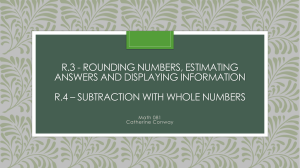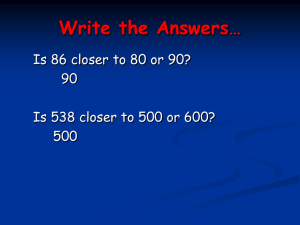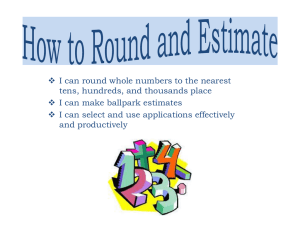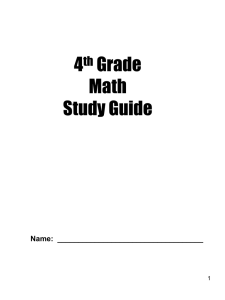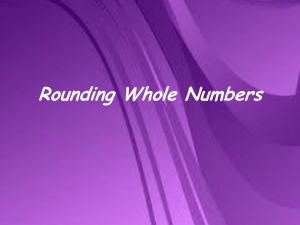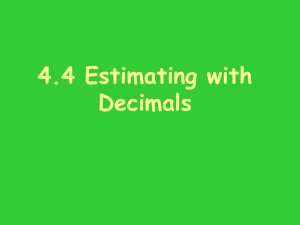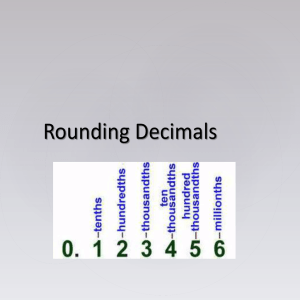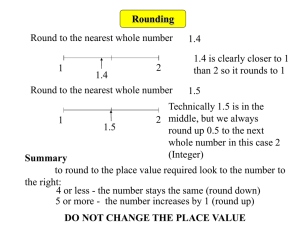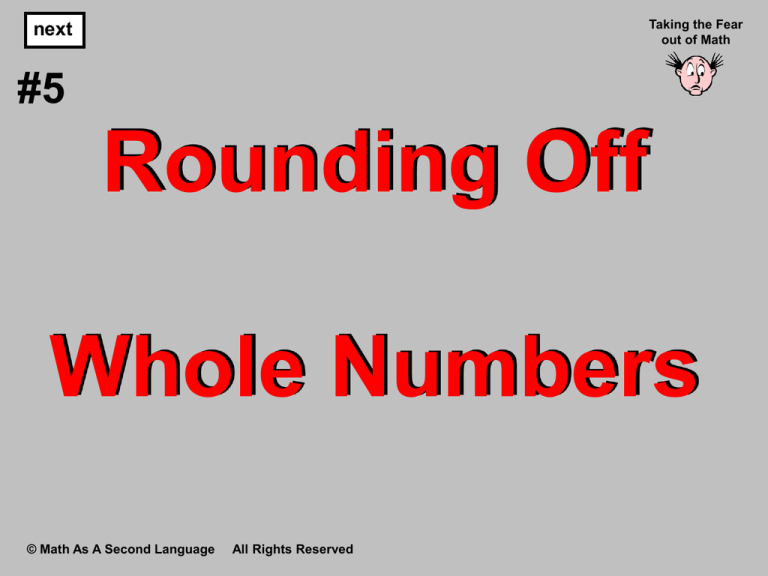
Taking the Fear
out of Math
next
#5
Rounding Off
Whole Numbers
© Math As A Second Language
All Rights Reserved
next
The Art of Estimating Whole Numbers
It is important to be able to make
reasonable estimates when we use the
traditional pencil-and-paper algorithms for
addition, especially when the addition
involves adding very large numbers.
The traditional algorithm has us doing the
arithmetic from right to left. Thus, we
would first add the 3 ones and 7 ones to
get 10 ones and our partial answer
1
would then look like…
3,895,567,893
+ 4,793,874,997
0
© Math As A Second Language
All Rights Reserved
next
1
3,895,567,893
3
+4
4,793,874,997
0
The point is that we get to the most
significant denomination (in this case,
billions) after we’ve been working the
longest, and hence, the most
likely to make a careless error.
© Math As A Second Language
All Rights Reserved
next
With the abundance of calculators now in
use, one might argue that there is no need to
go through learning to become an expert on
the addition algorithm. However, it is
possible that digits were entered
incorrectly.1
note
1To
paraphrase the National Rifle Association’s slogan,
“Calculators don’t make mistakes. The people who enter the numbers do!”
© Math As A Second Language
All Rights Reserved
next
So even with a calculator, one should
have enough number sense to be able
to estimate the answer even before
beginning to perform the actual
computation.2
For example, consider the following
addition problem…
3,895,567,893 + 4,793,874,997
note
2
Another problem with a calculator is that it can only store a certain number of digits.
So if the number is too great, the calculator will not be able to store all the digits.
© Math As A Second Language
All Rights Reserved
next
3,000,000,000
3,895,567,893
4,000,000,000
4,000,000,000
+ 4,793,874,997
5,000,000,000
Even if we were to use a calculator to find
the answer, we should first observe that
3,895,567,893 is greater than 3 billion but
less than 4 billion; while 4,793,874,997 is
greater than 4 billion but less than 5 billion.
© Math As A Second Language
All Rights Reserved
next
3 billion
3,895,567,893
4 billion
4 billion
+ 4,793,874,997
5 billion
7 billion
9 billion
From the above diagram, we see
that the sum has at least 7 billion,
but no greater than 9 billion.
© Math As A Second Language
All Rights Reserved
next
Note on Adjective/Noun Theme
Notice that we think of 3,895,567,893
as being a whole number. However, if the
noun is “billions”, it is not a whole number.
It is more that 3 billion but less than 4 billion.
In other words, in terms of numbers being
adjectives that modify nouns, suppose we
are “counting by billions,” which means that
instead of counting
“1, 2, 3…”
with no noun specified, we count
“1 billion, 2 billion, 3 billion…”
© Math As A Second Language
All Rights Reserved
next
Note on Adjective/Noun Theme
These numbers are called
multiples of a billion.
In the language of place value,
multiples of a billion end in nine 0’s.
Thus, the first six multiples of a billion are…
1,000,000,000
2,000,000,000
3,000,000,000
© Math As A Second Language
All Rights Reserved
4,000,000,000
5,000,000,000
6,000,000,000
next
If we are counting by billions, we might
ask the question…
“What number in our list of multiples of a
billion is closest in value to
3,895,567, 893?”.
The common mathematical wording
for this question is the statement…
“Round off the number 3,895,567, 893 to
the nearest billion.”
© Math As A Second Language
All Rights Reserved
next
Since the number 3,895,567,893 is
closer in value to 4 billion than to 3 billion,
the answer to this question is 4 billion;
or in the language of place value
4,000,000,000.
For example, let’s return to our original
addition problem.
3,895,567,893 + 4,793,874,997
© Math As A Second Language
All Rights Reserved
next
In the statement, “When rounded off to
the nearest billion, the number
3,895,567,893 becomes 4,000,000,000”, we
mean that among all possible multiples of
one billion, the multiple that gives the most
accurate approximation for 3,895,567,893 is
4,000,000,000.
Less than half
3,000,000,000
half
More than half
3,500,000,000 3,895,567,893 4,000,000,000
Since 3,895,567,893 is more than half way
between 3 billion and 4 billion, it is closer
to 4 billion.
© Math As A Second Language
All Rights Reserved
next
In a similar way, if we round off 4,793,874,997
to the nearest billion it becomes
5,000,000,000. That is, 4,793,874,997 is
greater than 4 billion, less than 5 billion, but
closer in value to 5 billion.
Less than half
4,000,000,000
half
More than half
4,500,000,000 4,793,774,997 5,000,000,000
Since 4,793,874,997 is more than half way
between 4 billion and 5 billion, it is closer
to 5 billion.
© Math As A Second Language
All Rights Reserved
So by rounding off each number to the
nearest billion…
next
3,895,567,893
4,000,000,000
+ 4,793,874,997
+ 5,000,000,000
…the addition problem becomes much less
cumbersome.
© Math As A Second Language
All Rights Reserved
This tells us, even before we begin to
do the actual arithmetic that the answer to
the addition problem…
next
3,895,567,893
4,000,000,000
+ 4,793,874,997
+ 5,000,000,000
9,000,000,000
…should be “around” 9 billion (or in
place value notation, 9,000,000,000)
© Math As A Second Language
All Rights Reserved
With respect to the above note, we are
able to find upper and lower bounds for the
sum 3,895,567,893 + 4,793,874,997
by observing that…
next
lower bound
underestimate
3 billon
+
actual
upper bound
number
overestimate
4 billon
< 3,895,567,893
< 4,793,874,997
7 billon
<
© Math As A Second Language
actual sum
All Rights Reserved
<
<
4 billon
<
9 billon
5 billon
next
Summary
The above upper and lower bounds tell us
that in addition to our estimate that the
sum is “around” 9 billion, that the correct
answer has to be greater than 7 billion but
less than 9 billion.
And we know all of this before we even
begin to perform the actual addition
(either by hand or with the aid of a
calculator).
© Math As A Second Language
All Rights Reserved
next
Doing the actual computation we see
that…
lower bound
underestimate
3 billon
+
actual
upper bound
number
overestimate
<
<
4 billon
4 billon
< 3,895,567,893
< 4,793,874,997
7 billon
<
8,689,442,890
<
9 billon
5 billon
The answer is reasonable in the sense that
it is within the range of our estimate.
© Math As A Second Language
All Rights Reserved
next
A “Reasonable” Note
For example, suppose that instead of
entering 4,793,874,997 on the calculator we
had erroneously entered 5,793,874,997.
In that case the calculator would have
given us 9,689,442,890 as the answer.
While there are many numbers between
7 billion and 9 billion,
9,689,442,890 is not one of them!
© Math As A Second Language
All Rights Reserved
A “Reasonable” Note
next
Clearly, there are many whole numbers
that are between 7 billion and 9 billion,
and as a result it is still possible that in
obtaining the above sum we made an
error in the arithmetic.
However, our estimate helps us to be
sure that we have not obtained
an unreasonable answer.
© Math As A Second Language
All Rights Reserved
next
One moral of this story is that
we do not have to know the
correct answer to conclude that
some answers are incorrect!
© Math As A Second Language
All Rights Reserved
next
The Rote Method for Rounding Off
Too often students are given a rote
“recipe” to follow which results in their
obtaining a correct estimate but without
properly understanding what has
happened.
For example, to round off 5,286 to the
nearest thousand, the recipe is…
© Math As A Second Language
All Rights Reserved
next
The Rote Method for Rounding Off
Step 1: Locate the place to which you’re
rounding off.
In this example, we are rounding 5,286 off
to the nearest thousand, so we locate the
thousands place. Using an asterisk to
locate the place, we obtain…
*5, 2 8 6
© Math As A Second Language
All Rights Reserved
next
Step 2: If the digit immediately to the
right of the asterisk is less than 5, simply
replace all of the digits to the right of the
arrow by 0’s.
*
5, 2
08
06
0
Our answer rounded to the nearest
thousand would be 5,000.
© Math As A Second Language
All Rights Reserved
Notice that the “short cut” is simply a
mechanical way to summarize the logical
way. To review this in greater detail, we
know that the multiples of a thousand end
in three 0’s. Hence, the first few multiples
of a thousand are 1,000, 2,000, 3,000, 4,000,
5,000, 6,000, etc.).
next
5,286 is greater than 5,000 but less than 6
thousand. Since 5,500 is halfway between
5,000 and 6,000, and 5,286 is between 5,000
and 5,500 it means that 5,286 is closer to
5,000 than 6,000.
© Math As A Second Language
All Rights Reserved
next
Step2: However, if the digit
immediately to the right of the asterisk is
greater than 5, we still replace every
digit to the right of the asterisk by 0, but
this time we add 1 to the number that is
left of the zeros.
For example, if we wanted to round off
56,892 to the nearest thousand, the asterisk
would be over the 6.
*
5 6, 9 8 2
© Math As A Second Language
All Rights Reserved
next
The digit to the right of the asterisk is 9.
Therefore, the digits to the right of the
asterisk become 0’s.
And we add 1 to 56 and get 57.
*
5 7,
6, 9
08
02
0
Our answer rounded to the nearest
thousand would be 57,000.
© Math As A Second Language
All Rights Reserved
next
Notice that the “short cut” is simply a
mechanical way to summarize the
logical way. To review this in greater detail,
we know that the multiples of a thousand
end in three 0’s. Hence, the first few
multiples of a thousand are 1,000, 2,000,
3,000, 4,000, 5,000, 6,000, etc.
When we count by thousands 56,892 is
between 56,000 and 57,000, and 56,892 is
between 56,500 and 57,000 (and therefore
closer in value to 57,000).
© Math As A Second Language
All Rights Reserved
next
Note on Rounding Up/Down
When rounding off numbers between 5,000
and 6,000 to the nearest thousand, all the
numbers less than 5,500 become 5,000 while
all numbers greater than 5,500 become
6 thousand.
A fine point occurs if the number is exactly
5,500 in which case we have to use our
own judgment when we round off to the
nearest thousand.
© Math As A Second Language
All Rights Reserved
Some books advise that in this case we
round up rather than down. That is, they
would round 5,500 off to 6,000. This can be a
bit “dangerous”.
next
For example, suppose we were adding
5,500 ten times. The exact answer would
be 55,000. However, if we round each term
up to the next thousand, the sum becomes
60,000 and if we round each terms down to
the next thousand, the sum becomes
50,000.
© Math As A Second Language
All Rights Reserved
A better strategy would be to alternate
between rounding up and rounding down.
In fact, in this illustration if we rounded half
of the terms up to 6,000 and the other half
down to 5,000, we would get the exact
answer as our approximation.
next
The important thing to remember is that
rounding off is just a tool for helping us
make estimates, and in that sense, it is a
supplement and not a replacement for us
using our own judgment.
© Math As A Second Language
All Rights Reserved
next
In other words, when we are given a
“rule of thumb” to follow, it should be
tempered by our own number sense.
© Math As A Second Language
All Rights Reserved
next
How we round off often depends on
the degree of accuracy that we require.
There are times when we might want to
round off 5,286 to the nearest hundred
rather than to the nearest thousand.
Counting by hundreds we see that 5,286 is
greater than the 52nd multiple and of a
hundred (5200) but less than the
53rd multiple of a hundred (5300).
Moreover, 5,286 is closer in value to 5,300
than it is to 5,200. Hence, to the nearest
hundred 5,286 rounds up to 5,300.
© Math As A Second Language
All Rights Reserved
next
Summary
5200
5250
5286
5300
(52nd multiple of 100)
(53rd multiple of 100)
Using the short cut, since we are rounding
off to the nearest hundred, our asterisk
goes over the 2. The digit to the right of 2
(namely, 8) is greater than 5. Hence, we
replace 52 by 53 and replace the remaining
digits by 0’s.
© Math As A Second Language
All Rights Reserved
next
rounding 1,875
© Math As A Second Language
2,000
In the next presentation,
we will talk about
unadding
(subtraction).
All Rights Reserved

